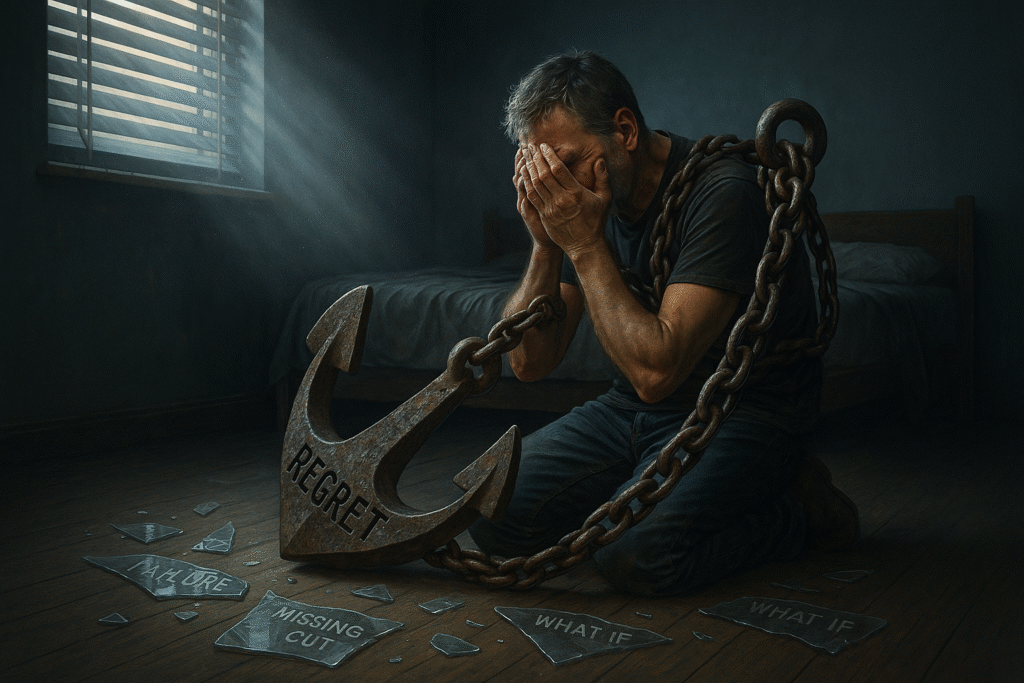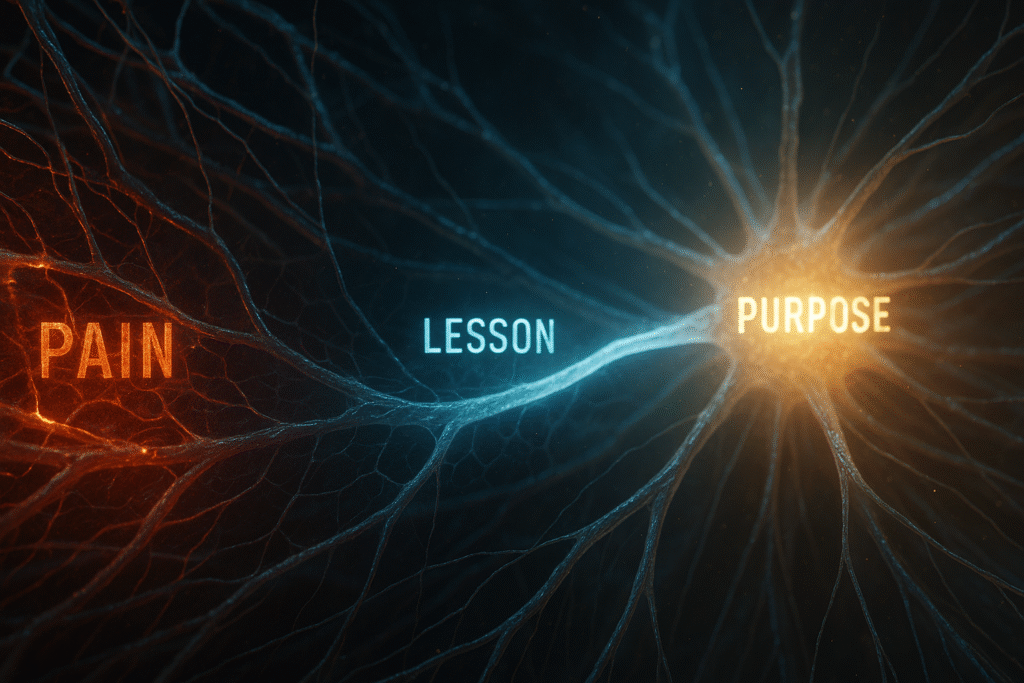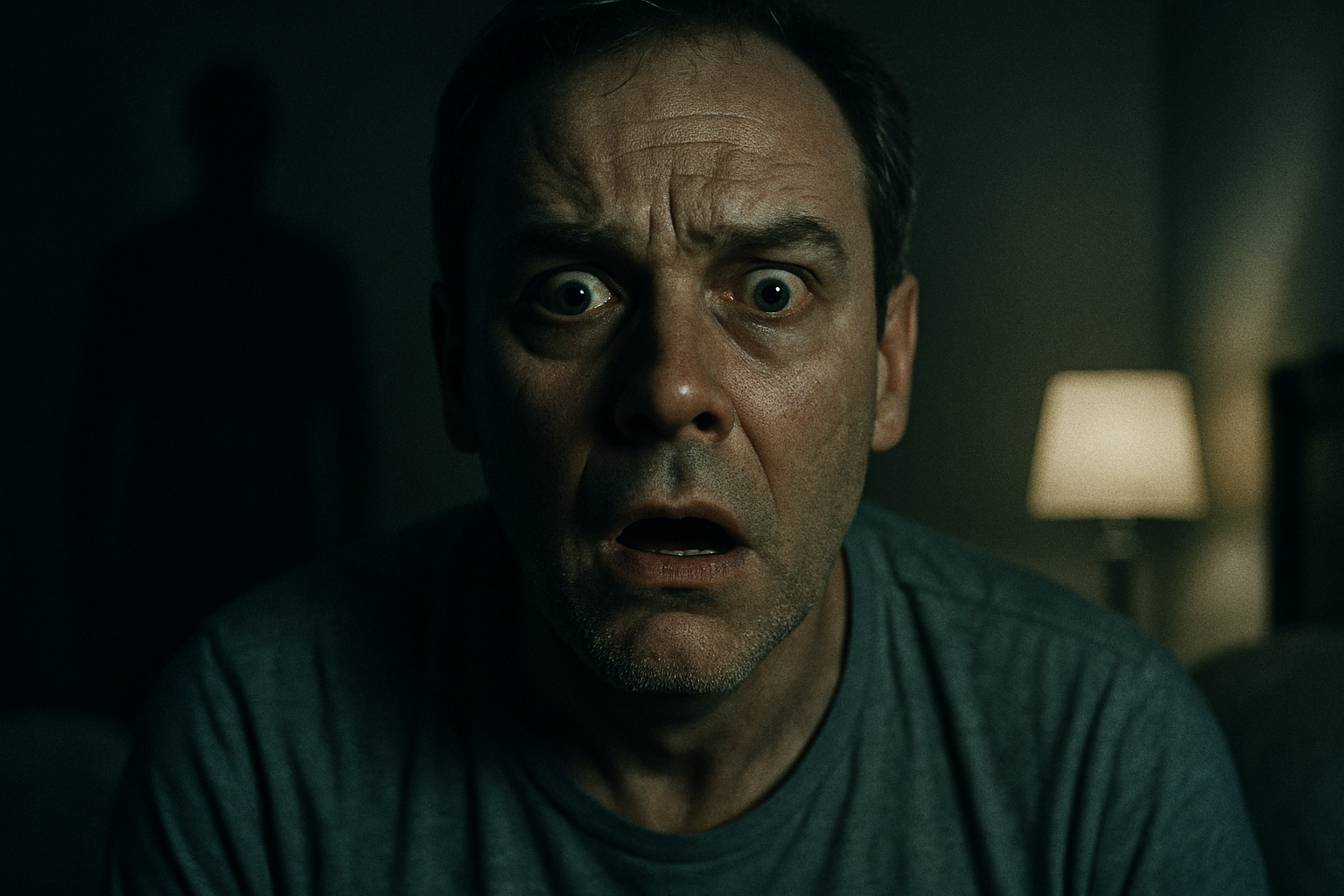Lost Dreams & Sleepless Nights: A Man’s Guide to Beating Regret

Table of Contents
Disclaimer: This content provides educational information only and should not replace professional medical, financial, or legal advice. Your individual circumstances are unique. We strongly recommend you consult with qualified professionals for personalized guidance before making any major life decisions.
(Estimated Reading Time: 13 minutes)
It’s 3 AM. The house is quiet, the world is asleep, but your mind is running a highlight reel of every wrong turn you’ve ever made. Your feeling like a failure in your 40s. The career you didn’t chase. The investment you passed on. The relationship you fumbled. The words you can’t take back.
For men in their 40s, 50s, and beyond, this isn’t just a fleeting moment of nostalgia; it can feel like a nightly haunting. We look at the scoreboard of our lives and see the points we left on the field. This feeling has a name: regret. And according to research, it hits harder and lasts longer than we might think. A 2018 study published by the American Psychological Association found that inaction regrets—the things we didn’t do—tend to sting more intensely over the long haul than the mistakes we actually made.
We’re at a unique point in our lives where the path behind us is long, and the path ahead, while full of potential, feels undeniably finite. It’s natural to look in the rearview mirror and wonder, “what if?” But here’s the hard truth many of us learn too late: allowing regret to fester turns it from a passing thought into a toxic anchor, holding us back from the very freedom and purpose we’ve worked decades to earn.
This isn’t another article that will tell you to “just let it go” or “think positive.” That’s useless advice. This is a strategic guide, a practical playbook for men who are ready to stop being haunted by the past. We’re going to dissect what regret actually is, understand the neurological mechanics that keep it on a loop in our brains, and most importantly, give you a practical, 4-step framework to transform it from a source of pain into a powerful catalyst for your second act.
By the end of this article, you will have a clear process for making peace with your past and building a future with intention. Let’s get to work.
Why Feeling Like a Failure in Your 40s Hits Men So Hard (And Why It’s Not Your Fault)
If you feel like regret has a death grip on you, you’re not alone, and it’s not a sign of weakness. For men, midlife is often a period of intense re-evaluation. We’ve spent decades building, providing, and climbing. Now, for the first time, we might have the space to look up and question the ladder we’ve been on. This process is driven by powerful psychological and neurological forces.
The Neuroscience of a Ruminating Brain
Our brains are wired with a powerful “what if” simulator. Psychologists call it counterfactual thinking—the tendency to imagine alternative outcomes to events that have already happened. While it can be a useful tool for learning, in midlife it can go into overdrive. You’re not just remembering a past event; your brain is actively simulating a different, often better, reality that never was.
Expert Insight: Neuroscientists at the Donders Institute found that our brains process regrets in the medial orbitofrontal cortex, the same area involved in planning and decision-making. As reported in a 2022 study in Scientific Reports, this suggests regret isn’t just a fleeting emotion; it’s a cognitive tool meant to help us make better future choices. The problem arises when we get stuck in the analysis phase and never move on to the “better choice” part.
This neurological process is amplified by decades of social conditioning. Men are often taught to equate their self-worth with their achievements—our career, our net worth, our status. When we perceive a gap between our actual life and the “ideal self” we thought we’d be, regret rushes in to fill the void.
Action vs. Inaction: The Two Types of Regret That Haunt Us
It’s crucial to understand that not all regrets are created equal. Researchers generally split them into two categories:
- Regrets of Action (Commission): These are the things you did but wish you hadn’t. You made a bad investment, took the wrong job, or said something hurtful. These regrets tend to be sharp and painful initially, but they often fade with time as we learn from the direct consequences.
- Regrets of Inaction (Omission): These are the things you didn’t do. The business you never started, the woman you never asked out, the move you never made. As the APA study showed, these are the ghosts that tend to linger. Why? Because the possibilities are endless. Your brain can fantasize about a perfect, imagined outcome that was never tested against reality, making it seem far more appealing than it might have been.
For men in their second act, regrets of inaction often dominate. We see the doors that have closed and mourn the opportunities we feel we’ve missed, forgetting that new doors are waiting to be opened.
The High Cost of Unchecked Regret: More Than Just Bad Memories

Letting regret run on a constant loop in your mind—a process known as rumination—isn’t just mentally exhausting. It has a measurable, physical cost that can sabotage your health, wealth, and relationships in your most valuable decades.
When you constantly dwell on past mistakes, your brain signals to your body that you are under chronic threat. This isn’t just a feeling; it’s a physiological event. Your adrenal glands release a steady drip of cortisol, the primary stress hormone. According to the National Institutes of Health (NIH), chronic elevation of cortisol can wreak havoc on your body, contributing to:
- Increased blood pressure and heart disease risk.
- Poor sleep quality and insomnia.
- Weakened immune system.
- Weight gain, particularly around the abdomen.
- Anxiety and depression.
Beyond the direct health impacts, unchecked regret leads to decision paralysis. When you’re constantly second-guessing your past, you lose confidence in your ability to make good choices for your future. You become risk-averse, staying in a job you hate or a financial strategy that’s not working because the fear of making another “wrong” move is paralyzing. This is how men get stuck. Regret becomes the anchor that keeps your ship of life rusting in the harbor instead of sailing toward new horizons.
The ‘Regret Reframing’ Framework: A 4-Step Process for Moving Forward

So, how do we break the cycle? Not by ignoring regret, but by engaging with it strategically. We have to transform it from a source of shame into a source of data. In my experience, both personally and in speaking with psychologists and performance coaches, this requires a structured process.
I call it the ‘Regret Reframing’ Framework. It’s a simple, four-step method to take any regret, strip it of its emotional power, and convert it into fuel for your future.
Step 1: Isolate & Articulate (The ‘Unspoken Truth’ Audit)
Regret thrives in the dark, messy corners of your mind where it can remain vague and undefined. Its power comes from this ambiguity. The first step is to drag it into the light. You cannot fight an enemy you cannot see.
This means getting specific. Vague regrets like “I wasted my 30s” are impossible to solve. You need to distill that feeling into a concrete, specific event or decision.
Quick Action: Grab a notebook right now. Don’t use a computer; the physical act of writing is more powerful. Write down one specific regret that’s been on your mind. Don’t judge it, don’t analyze it, just state it in a single, clear sentence. For example: “I regret not starting that consulting business 10 years ago because I was afraid to leave my stable job.” This simple act of articulation is the first and most critical step to taking back control.
Step 2: Extract the Lesson (From Pain to Data)

Once you’ve articulated the regret, your next task is to treat it like a flight data recorder after a crash. Your job is not to beat yourself up over the crash; it’s to dispassionately analyze the data to ensure you fly better in the future.
Ask yourself one powerful question: “What specific knowledge did I gain from this experience that I can use today?”
Notice the wording. It’s not “What did I do wrong?” which invites shame. It’s “What knowledge did I gain?” which implies value. Your past mistake is now a piece of intelligence.
For the regret “I regret not starting that business,” the lessons might be:
- I learned that I value autonomy and building something of my own.
- I learned that my tolerance for financial risk was lower than I thought at the time.
- I learned that fear of failure can be a more powerful de-motivator for me than the promise of success.
This isn’t about making excuses. It’s about an honest assessment. You are transforming an emotional burden into an objective, useful set of data points.
Step 3: Reframe the Narrative (Becoming the Editor of Your Story)
We are all storytellers, and the most important story we tell is the one we tell ourselves about ourselves. The past event is fixed—you can’t change it. But your interpretation of that event, the narrative you build around it, is entirely within your control.
Most men stuck in regret are telling themselves a victim narrative: “I failed. I missed my chance. It’s too late.”
Your job is to become the editor of that story and reframe it into a narrative of growth and resilience. Using the lessons from Step 2, you can create a new, more powerful story.
- Old Narrative: “I was a coward for not starting that business. I blew my one shot.”
- New, Reframed Narrative: “My decision to stay in my corporate job 10 years ago taught me a critical lesson about my personal risk tolerance. That stability allowed me to build a strong financial base, and the skills I learned there are the exact skills I can now use to build something new, but in a smarter, less risky way.”
See the difference? The facts are the same, but the story is completely different. One leads to paralysis; the other leads to possibility.
Step 4: Take Corrective Action (The ‘Second Act’ Pivot)
This final step is what separates men who stay stuck from men who move forward. Insight without action is worthless. You must close the loop by taking a tangible, forward-looking action based on the lesson you extracted.
This action does not need to be monumental. In fact, it’s better if it’s small and immediate. The goal is to create momentum and prove to your brain that you are no longer defined by the past decision.
- If your regret is about the business you never started, the corrective action isn’t to quit your job tomorrow. It’s to spend one hour this weekend outlining a business plan. Or call one person in your network who runs their own business and ask for advice.
- If your regret is about a relationship you let fade, the action isn’t to book a flight. It’s to send a single text message: “Hey, was just thinking about you. Hope you’re doing well.”
This small, corrective action sends a powerful signal to your subconscious: “I am in control. The past informs me, but it does not define me.”
Here is the entire framework in a scannable format:
| Step | Action Item | Goal |
| 1: The ‘Unspoken Truth’ Audit | Isolate & Articulate: Write down a specific regret in one clear sentence. | To move the regret from an abstract feeling to a concrete problem you can solve. |
| 2: From Pain to Data | Extract the Lesson: Ask “What specific knowledge did I gain from this experience?” List 2-3 bullet points. | To transform an emotional burden into an objective, useful piece of data for future decisions. |
| 3: Editor of Your Story | Reframe the Narrative: Rewrite the story of the regret, focusing on the lesson learned and subsequent growth. | To change your internal monologue from one of failure to one of resilience and learning. |
| 4: The ‘Second Act’ Pivot | Take Corrective Action: Identify one small, immediate action you can take based on your extracted lesson. | To prove to yourself that the past no longer controls your future and to build forward momentum. |
Putting It Into Practice: Real-World Scenarios for Men 40+
Let’s see how this framework applies to the common regrets that keep us up at night.
Common Mistake: The biggest mistake we make is confusing a past event with a permanent character flaw. A past bad decision doesn’t make you a bad decision-maker forever. It makes you a person who now possesses valuable, hard-won data on what not to do next. You must learn to separate the action from your identity.
Scenario 1: The Career You “Should Have” Pursued
- Regret (Step 1): “I regret becoming an accountant to please my parents instead of pursuing my passion to be a chef.”
- Lesson (Step 2): “I learned that seeking external validation over my own internal compass leads to dissatisfaction. I also learned that I am highly skilled at managing details and finances, and I enjoy the structure of a well-run system.”
- Reframe (Step 3): “My accounting career wasn’t a mistake; it was a 20-year apprenticeship that gave me an incredible financial education and the capital I need for my next move. Now I can approach my passion for food not as a broke 22-year-old, but as a savvy 48-year-old who understands profit margins and business operations.”
- Action (Step 4): Sign up for a high-end weekend cooking class. Start a food blog where you analyze the business models of successful restaurants. Offer to do the books for a local cafe for free to learn the industry.
Scenario 2: The Financial Decision That Got Away
- Regret (Step 1): “I regret selling my Amazon stock in 2005. I’d be a multi-millionaire.”
- Lesson (Step 2): “I learned that I let fear drive my short-term financial decisions. I learned that I didn’t have a clear long-term investing philosophy, so I was easily swayed by market noise.”
- Reframe (Step 3): “That painful decision was the catalyst for me to get serious about financial education. It forced me to stop gambling and start investing with a real strategy. The money I ‘lost’ was the price of admission for a PhD in financial discipline that has served me far better in the long run.”
- Action (Step 4): Write down your personal investment philosophy in 200 words or less. Automate your monthly investments so emotion is removed from the equation. Schedule a meeting with a certified financial planner.
Scenario 3: The Relationship You Let Slip
- Regret (Step 1): “I regret losing touch with my best friend from college after we had a stupid argument.”
- Lesson (Step 2): “I learned that my pride can get in the way of relationships that matter. I learned that waiting for the other person to make the first move is a losing strategy.”
- Reframe (Step 3): “That experience taught me the profound value of proactive friendship. It made me a better husband, a better father, and a better friend to the people currently in my life because I now understand that connection requires consistent effort.”
- Action (Step 4): Find him on social media and send a simple message. No need to re-litigate the past. Just: “Hey [Name], crazy it’s been so long. Life gets in the way. I was thinking about you the other day and just wanted to say I hope you’re doing great.”
Your Second Act Starts Now: Beyond Regret to Purpose
The goal is not to live a life free of regret. Only a sociopath or someone who has never taken a single risk can claim that. A life well-lived is full of decisions, and some of those will inevitably be mistakes.
The goal is to change your relationship with regret.
It’s time to stop seeing it as a sign of your failure and start seeing it for what it is: a signal from your deepest self about what you truly value. Regret is a compass. It points directly to the gap between the life you’re living and the life you want. The pain you feel isn’t just pain; it’s information. It’s guidance.
Your past is not a life sentence; it’s a library of lessons you’ve already paid for. It’s time to start using them. You have decades of experience, wisdom, and resilience that your 25-year-old self could only dream of. The man you are today is uniquely equipped to build a second act that is richer, more intentional, and more meaningful than the first.
Stop letting the ghosts of yesterday dictate the reality of tomorrow. Pick one regret. Walk it through the four steps. Take one small action. Today.
Your past is data, not your destiny. Your second act is waiting.
- Source 1 (Psychology): Davidai, S., & Gilovich, T. (2018). The ideal road not taken: The highs and lows of thinking about the ideal self. Emotion, 18(3), 433–444. Link:
https://psycnet.apa.org/record/2017-37602-001 - Source 2 (Neuroscience): van Mierlo, C., & Rijpkema, M., et al. (2022). Neural correlates of state and trait regret in the medial orbitofrontal cortex. Scientific Reports, 12(1), 1933. Link:
https:https://psycnet.apa.org/record/2017-37602-001//www.nature.com/articles/s41598-022-05995-6 - Source 3 (Health Impact): NIH News in Health. (2023, April). Stressed Out? How Chronic Stress Takes a Toll. Link:
https://newsinhealth.nih.gov/2023/04/stressed-out - Source 4 (Behavioral Science): Roese, N. J., & Summerville, A. (2005). What we regret most: A smart-phone study of the frequency of self-reported regret. Social Psychological and Personality Science, 6(3), 187-194. Link:
https://journals.sagepub.com/doi/10.1177/1948550614551520 - Source 5 (Clinical Perspective): Johns Hopkins Medicine. The Surprising Benefits of Regret. Link:
https://www.hopkinsmedicine.org/health/wellness-and-prevention/the-surprising-benefits-of-regret







